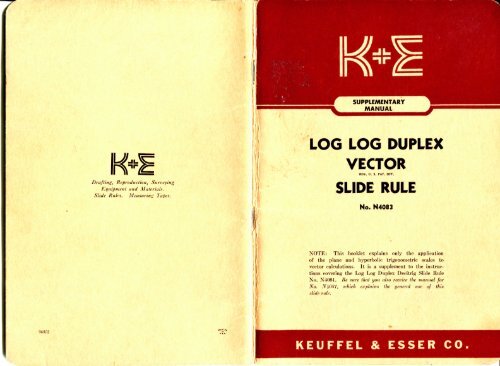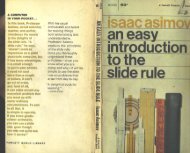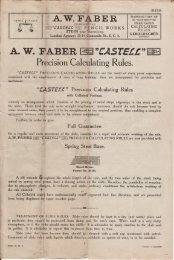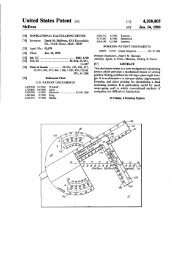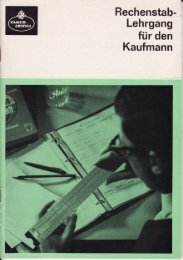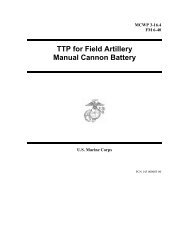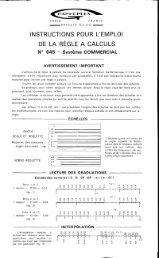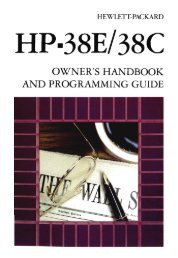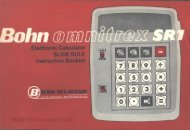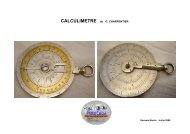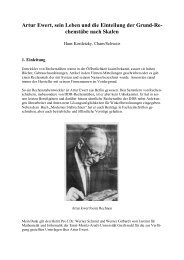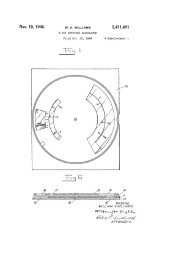11.6MB - Slide Rule Museum
11.6MB - Slide Rule Museum
11.6MB - Slide Rule Museum
You also want an ePaper? Increase the reach of your titles
YUMPU automatically turns print PDFs into web optimized ePapers that Google loves.
M'-"lrvr,<br />
Drafting, Reproduction, Surveying<br />
Equipment uiiti Materials.<br />
Slitle Ruli's. afffaSitrfag Tapes,<br />
LOG LOG DUPLEX<br />
VECTOR<br />
REG. U. S. PAT. OFF.<br />
SLIDE RULE<br />
No. N4083<br />
NOTE: This booklet explains only the application<br />
of the plane and hyperbolic trigonometric scales to<br />
vector calculations. It is a supplement to the instructions<br />
covering the Log Log Duplex Decitrig <strong>Slide</strong> <strong>Rule</strong><br />
\o. N108I. Be .turc that you nl.w rcceim the manviil fnr<br />
A'o. N'lONl, irliii'lt ej-jilniiin the t/fiifr/il imf of llu'x<br />
xl'idt' rule.<br />
KEUFFEL & ESSER CO.
Copyright 1939 By Keuffel & Esser Co.<br />
LOG LOG DUPLEX<br />
VECTOR<br />
REG. U. S. FAT. OFF.<br />
SLIDE RULE<br />
No. N4083<br />
SUPPLEMENTARY MANUAL<br />
NOTE: This booklet explains only the application<br />
of the plane and hyperbolic trigonometric scales to<br />
vector calculations. It is a supplement to the instructions<br />
covering the Log Log Duplex Decitrig <strong>Slide</strong> <strong>Rule</strong><br />
No. N4081. Be sure that you also receive the manual for<br />
No. N4081, which explains the general u
GB<br />
cc<br />
O<br />
O LU<br />
X<br />
u<br />
_l<br />
Q.<br />
D;<br />
O<br />
O<br />
o<br />
u<br />
I<br />
:JJ1<br />
S=LF<br />
lir<br />
S3 H<br />
ill jo<br />
•fa<br />
a<br />
ft<br />
e<br />
SS<br />
PREFACE<br />
The K & E Log Log Duplex Vector <strong>Slide</strong> <strong>Rule</strong> has<br />
all of the scales of the Log Log Duplex Decitrig <strong>Slide</strong> <strong>Rule</strong><br />
with the exception of scales DI and K which are displaced<br />
to make room for the three scales of hyperbolic functions.<br />
Cubes and cube roots may be readily found by use of the log<br />
log scales; and it may be noted in the explanations given<br />
in the manual of the Log Log Duplex Decitrig <strong>Slide</strong> <strong>Rule</strong>,<br />
which accompanies this booklet, that the DI scale is not<br />
essential to the efficient employment of this rule.<br />
It is suggested to the users of this slide rule<br />
that they should become thoroughly familiar with its appli-<br />
cation to calculating processes through thorough study of<br />
the instruction manual on the Log Log Duplex Decitrig <strong>Slide</strong><br />
<strong>Rule</strong>. The latter which is also supplied with the Log Log<br />
Duplex Vector <strong>Slide</strong> <strong>Rule</strong>, includes a very thorough discus-<br />
sion of the solution of the right triangle on which vector<br />
calculations are based.<br />
This manual on the Log Log Duplex Vector <strong>Slide</strong><br />
<strong>Rule</strong> deals specifically with the general application of the<br />
trigonometric and hyperbolic scales to vector calculations,<br />
with examples illustrating their specific application to<br />
problems encountered in electrical engineering.
C O N T E N T S<br />
1.<br />
Page<br />
I. PLANE VECTOR CALCULATIONS 2<br />
(A) Conversion of a + jb into A/6 2<br />
(B) Conversion of A/Q into a + jb 4<br />
Illustrative Applications 5<br />
II. HYPERBOLIC FUNCTIONS 7<br />
(A) The Hyperbolic Sine and Tangent Scales .... 7<br />
(B) Evaluation of the Hyperbolic Cosine 8<br />
III. HYPERBOLIC FUNCTIONS OF COMPLEX NUMBERS 9<br />
(A) VECTOR EQUIVALENTS OF sinh (x + J9) 9<br />
(1) <strong>Slide</strong> <strong>Rule</strong> Method for Calculating the<br />
Numerical Value of sinh (x + j6) 10<br />
(2) <strong>Slide</strong> <strong>Rule</strong> Method for Calculating the<br />
Angle of sinh (x + je) 11<br />
Illustrative Application 17<br />
(B) VECTOR EQUIVALENTS OF cosh (x + J6) 18<br />
(1) <strong>Slide</strong> <strong>Rule</strong> Method for Calculating the<br />
Numerical Value of cosh (x + j6) 19<br />
(2) <strong>Slide</strong> <strong>Rule</strong> Method for Calculating the<br />
Angle of cosh (x + je} 19<br />
Illustrative Application 25<br />
(C) CALCULATION OF THE VECTOR VALUE OF tanh<br />
(x + J6).. 26<br />
IV. INVERSE HYPERBOLIC FUNCTIONS OF COMPLEX NUMBERS. 28<br />
(A) SLIDE RULE CALCULATION of sinh"1 (AJ3_) 28<br />
(B) SLIDE RULE CALCULATION of cosh"1 (B^oJ 30<br />
(C) SLIDE RULE CALCULATION of tanh-1 (D/S) 31<br />
ILLUSTRATIVE PROBLEMS 32
-2-<br />
THE K & E LOG LOG DUPLEX VECTOR SLIDE RULE<br />
PLANE VECTOR CALCULATIONS<br />
(See also Bages 62 to 65 in the Manual of<br />
the Log Log Duplex Decitrig <strong>Slide</strong> <strong>Rule</strong>.)<br />
Plane vectors of the form Ae1' = A/6. when subject to<br />
processes of addition or subtraction, must be converted into<br />
their horizontal and vertical components,jointly expressed in<br />
complex notation of the form a + jb. The quantity "a" is the<br />
horizontal component, "b" is the vertical component end the<br />
symbol 3 =~V^T,called "operator",indicates that the component<br />
"b" is 90° in counter clockwise direction from the horizontal<br />
component "a" as shown in the figure.<br />
The exponential form of vectors lends itself more conveniently<br />
to the processes of multiplication and division, involution<br />
and evolution. Hence when such calculations are to<br />
be performed on complex numbers of the form a + jb, it is<br />
necessary to convert them first into the exponential form.<br />
The following rules of conversion are based upon the<br />
trigonometric relationship which exists between the components<br />
of the vector forming the sides of a right triangle, and the<br />
hypothenuse or absolute value of the vector.<br />
(A) CONVERSION OF a + jb INTO A/6 (See Fig. above ).<br />
<strong>Rule</strong>; Set an index of the slide to the larger side<br />
"a" (or "b") on scale D. Opposite the shorter<br />
side "b" (or "a") on scale D read angle "6" on<br />
scale T. Move slide so as to bring angle "6" on<br />
scale S opposite the shorter side, and at the slide<br />
index read "A" on scale D.<br />
If side "a" is the larger side, angle "6" is<br />
smaller than 45°; if side "a" is the smaller<br />
side, angle "6" is greater than 45°. This should<br />
be taken into consideration when reading angle "6"<br />
on scale T. In the first case the Mack numbering<br />
of scale T is used, whereas in the second case the<br />
red numbering of scale T is used.<br />
Example 1;<br />
-3-<br />
Find the vector value of 4 + J3.<br />
The vertical component is smaller than the horizontal<br />
component, therefore angle 9 < 45°.<br />
To 4 on scale D set right slide index.<br />
Example 2:<br />
At 3 on scale D read ft = 36.87° on scale T.<br />
Move 36.87° on scale S<br />
At slide index read A<br />
to<br />
= 5<br />
Hence 4 + J3 = 5/36.87°<br />
Find the vector value of 3 + J4.<br />
3 on scale D.<br />
on scale D.<br />
Here the vertical component is greater than the horizontal<br />
component, therefore angle 6 > 45°.<br />
To 4 tin scale D set right slide index.<br />
At 3 on scale D read 0 = 53.13° on scale T.<br />
Move 53.13° on scale S (red) to 3 on scale D.<br />
At slide index read A = 5 on scale D.<br />
Example 5:<br />
Example 4:<br />
Hence<br />
= 5/55.15°<br />
Find the vector value for 9.68 ± J6.9.<br />
9 < 45°.<br />
To 9.68 on scale D set right slide index.<br />
At 6.9 on scale D read 6 = 35.5° on scale T.<br />
Move 35.5° on scale S to 6.9 on scale D.<br />
At slide index read A = 11.9 on scale D.<br />
Hence 9.68 ± 36.9 = 11.9/1 35.5'<br />
1.91 + 30.05.<br />
Since, °-05 < 0.1, the angle "9" can not be read on<br />
-L«y j_<br />
scale T, but will have to be read on scale ST.<br />
To 1.91 on scale D set left slide index.<br />
At 0.05 on scale D read 6 = 1.5° on scale ST.<br />
With the vector angle so small, the difference between<br />
the numerical value of the vector, "A", and the horizontal<br />
component will be so small that<br />
for all practical purposes.<br />
1.91 + 30.05 = 1.91/1.5°
Example 5 :<br />
-4-<br />
A more accurate value of "A" is<br />
A = a +<br />
0.5 b^<br />
when b < and<br />
Thus for the preceding example<br />
O.Ofif) + 31.49.<br />
A = 1.91 + °-5 (°-05)S<br />
j- • y _L<br />
we have<br />
1.910654.<br />
Sirioe , ^'^ ) 10 , the angle "9" can not be read on scale T<br />
0.065<br />
(red), and its value will have to be found on scale ST as follows:<br />
To 1.49 on scale D set left slide index.<br />
At 0.065 on scale D read 2.5° on scale ST.<br />
90° - 2.5° = 6 = 87.5° .<br />
Since, 1.49 is comparatively large with respect to 0.065,<br />
it follows that for all practical purposes<br />
More accurately we get<br />
0.065 + 31.49 = 1.49/87.5°.<br />
A = 1.49 + 0.5(0.065)8 =<br />
(B) CONVERSION OF INTO a jb.<br />
Given AeJ'6 = A/e, find a + jb.<br />
The complex expression for A/6 is (A cos 9 + jA sin 6).<br />
Since scale D frives sin 6 for values of "6" on scale S (black).<br />
and cos 6 for values of "6" on scale S (red), the above notation<br />
can be evaluated by one setting of the scales S and D.<br />
Example 6 :<br />
<strong>Rule</strong>: To "A" on scale D set an index of the slide.<br />
"~ At "6" on scale S (black) read the vertical,<br />
or imaginary component, and at "6" on scale S (red)<br />
read the horizontal or real component.<br />
Find the complex number equivalent to 5/36.87° .<br />
To 5 on scale D set right slide index.<br />
At 36.87° on scale S (black) read b = 3 on scale D.<br />
At 36.87° on scale S (red) read a = 4 on scale D.<br />
Hence<br />
Example 7;<br />
Example 8:<br />
-S-<br />
Find the complex number equivalent to 11.9/-54.50.<br />
To 11.9 on scale D set left slide index.<br />
At 54.5° on scale S (black) read b = 9.69 on scale D.<br />
At 54.5° on scale 3 (red) read a = 6.91 on scale D.<br />
Hence 11.9/-54._5°_ = 6.91 - 39.69.<br />
Find the complex number equivalent to 1.83/2.5°.<br />
To 1.83 on scale D set left slide index.<br />
At 2.5° on scale 3T read b = 0.0798 on scale Di<br />
For all practical purposes<br />
1.85/2.5° = 1.83 + 30.0798.<br />
As under the previous article we can find a more accurate<br />
value for "a" by the following formula:<br />
A -<br />
T83<br />
0.5 x (0.0798)2<br />
1.83<br />
- 0.00174 = 1.82826<br />
ILLUSTRATIVE APPLICATIONS<br />
1. A circuit consists of a resistance of 7.46 ohms,<br />
in series with an inductive reactance of 3.4 ohms. What is<br />
the vector impedance of the circuit?<br />
Z = 7.46 + 33.4 = 8.2/24.5° vector ohms.<br />
2. Calculate the vector impedance of a circuit which<br />
consists of a resistance of 0.795 ohms in series with a capacitive<br />
reactance of 1.25 ohms.<br />
Z = 0.795 - jl.25 = 1.48/-57.54° vector ohms.<br />
3. A circuit consists of a resistance in parallel<br />
with a capacitance. The measured current in the resistance is<br />
10.5 amperes, and that in the capacitance is 5.7 amperes. What<br />
is the total current in the circuit? What is its time phase<br />
with respect to the difference of potential impressed upon the<br />
circuit? What is the power factor?<br />
I = 10.5 + 35.7 = 11.95/28.5° vector amperes.<br />
The time phase is 28.5° leading.<br />
The power factor is cos 28.5° = 0.878.
-6-<br />
4. A circuit consists of a conductance of 0.068 mhos<br />
in parallel with a practically pure inductive susoeptanco of<br />
0.0872 mhos. What is the vector admittance of the circuit?<br />
Y = 0.068 - j'0.087 = 0.1105/-52° vector mhos.<br />
5. The attenuation constant and the wave length constant<br />
of No.10 A.W.G-. dry core cable at 800 cycles frequency are<br />
a = 0.0366 and /S = 0.0559 hyperbolic and circular radians, respectively.<br />
What is the propagation constant of the line?<br />
p = a + jb = 0.0366 + J0.0559.<br />
= 0.067/56.8°.<br />
6. The vector impedance of a circuit ia 7.9/gr;.5° ohms.<br />
Calculate its resistive and reactive conponents. J<br />
7.9/25.5° «= 7.13 + J3.4.<br />
Hence r = 7.13 ohms and x = 3.4 ohms.<br />
7. The admittance of a parallel circuit is 0.0955/-31.5°<br />
vector ohms. Calculate the conductance and susceptance of thecircuit.<br />
The conductance is:<br />
and the susceptance is:<br />
The complex expression<br />
for the admittance is :<br />
g = 0.0955 cos (-31.5°) = 0.0814 mhos,<br />
b = 0.0955 sin (-31.5°) = -0.0499 mhos.<br />
g-jb = 0.0614 - J0.0499<br />
8. The vector propagation constant of a certain transmission<br />
line is<br />
p = 0.065/56.5°.<br />
Calculate the attenuation and phase constant.<br />
The attenuation constant is:<br />
a = 0.065 cos 56.5° = 0.03585 hyperbolic radians.<br />
The phase constant is:<br />
/3 = 0.065 sin 56.5° = 0.0542 circular radians.<br />
The wave length constant is identical to the phase constant ,but ifi<br />
usually expressed in degrees. Its value for the given line is:<br />
0.0542 x 57.3 = 3.11°.<br />
(One radian = 57.3°).<br />
II<br />
HYPERBOLIC FUNCTIONS<br />
(A) TK5 HYPERBOLIC SINE AND TANGEMT_SCALES<br />
1. Since for sll practical purposes sinh x = x, and<br />
hanh x = x, when x ( 0.1, scale D gives tlio sinh x and tanh x<br />
directly for any value of x < 0.1.<br />
2. Scale D in conjunction with scale Shi gives the<br />
hyperbolic sines of hyperbolic angles x for any value between<br />
0.1 < x < 0.882. Thus for x = 0.515 set indicator on 0,515<br />
scale 3hl and real 0.538 = sinh 0.515 on scale D.<br />
Similarly: sinh 0.645 = 0.59<br />
sinh 0.1945 = 0.1956<br />
sinh 0.2V5 = 0.276<br />
Conversely, scale Shi gives the hyperbolic angle x<br />
corresponding to sinh x between "values of 0.1 and 1.0. Thus<br />
for sinh x = 0.758 on D, read x = 0.7 on Shi scale. lor<br />
sinh x = 0.249 on D, read x = 0.24-66 on 3hl.<br />
5, Scale ShS in conjunction with scale U gives the<br />
hyperbolic angle "x" for values of sinh x between values of<br />
1 and 10 as read on scale D. Thus for 1,592 = sinh x as read<br />
on scale D, we get x - 1.245 on scale ;3hS, Conversely, scale D<br />
gives the corresponding valuer, of sinh x for? values of "x" betwoen<br />
0.882 and 3.0 on scale Sh2. Thus for x = 1.245 on scale<br />
Sh2, read sinh x = 1.592 on scele D.<br />
Similarly: sinh 1.465 = 2.05<br />
sinh 1.875 = 3.18<br />
sinh 2.24 =4.64<br />
sinh 2.95 = 9.53<br />
For:sinh x = 5.1<br />
sinh x = 4.35<br />
sinh x = 1.84<br />
on D read x = 2.332 on ShS.<br />
on D read x = 2.176 on ShS.<br />
on D read x = 1.37 on Sh2.<br />
4. Scale Th gives the hyperbolic angle "x" for values<br />
of tanh x between 0.1 and 1.0, and conversely scale D gives<br />
the values of tanh. x for values of "x" between 0.1 and 3.0.<br />
Thus for x = 0.175 en scale Th, we read 0.1733 on scale D.<br />
For values of "x" larger than 3.0, the hyperbolic tangent is<br />
substantially equal to 1.0.<br />
Similarly: tanh 0.224<br />
tanh 0.435<br />
tenh 0.94<br />
tanh 1.45<br />
tanh 2.<br />
tanh 3.<br />
0.2202<br />
0.409<br />
0.735<br />
0.895<br />
0.964<br />
0.995
-e-<br />
For: tanh x = 0.795 on D, read x = 1.085 on Th<br />
tanh x = 0.52 on D, read x = 0.576 on Th<br />
tanh x = 0.137 on D, read x = 0.138 on Th<br />
(B) EVALUATION OF THE HYPERBOLIC COSINE<br />
The hyperbolic cosine of any real number x, may be ob-<br />
tained by any of the following formulas:<br />
or<br />
cosh x =<br />
sinh x<br />
tanh x<br />
+ sinh2x<br />
sinh x<br />
sin [tan-1 (sinh x)]<br />
Formula (1) is best suited for slide rule calculation,<br />
and the value of cosh x, can be obtained at,<br />
a single setting of the slide.<br />
<strong>Rule</strong>: Set an index of the slide to "x" on scale<br />
Th. Move indicator to "x" on scale Shi<br />
or Sh2 and read cosh x on scale 0, on the<br />
reverse side of the rule.<br />
Example:<br />
Example:<br />
Find cosh 0.662<br />
Set left index of slide to 0.662 on scale Th.<br />
Move indicator to 0.662 on scale Shi and<br />
read 1.227 = cosh x, on scale 0.<br />
Find cosh 1.57.<br />
Set right index of slide to 1.57 on scale Th.<br />
Move indicator to 1.57 on scale Sh2 and<br />
read 2.508 = cosh x, on scale 0.<br />
(1)<br />
(2)<br />
(3)<br />
III<br />
HYPERBOLIC FUNCTIONS OF COMPLEX NUMBERS<br />
(A) VECTOR EQUIVALENTS OF sinh (x + J6).<br />
The hyperbolic sine of a complex number is a<br />
pi ex number.<br />
/<br />
sinh x cos 6<br />
Thus sinh (x + JO) = (sinh x cos 6) + jfcosh x sin 6 ). (D<br />
The vector value of this expression is, tlierefore<br />
sinh x cos 6<br />
cosp<br />
or A = i/sinh2 x + sin2 e<br />
CD<br />
a<br />
•H «.<br />
1*1<br />
£1 m0o<br />
sinh (x + J6) = A^J.<br />
i f\ooah x sin 6^ tnn-1/*6111 6\d P Laii (sinh x cos (5) e) tan<br />
I -••( l \<br />
~ Lcl11 Uanh x/ tan e]<br />
_l/ tanh x \ tan 6 /<br />
= cot" -'-(tanh x cot 6)<br />
com-<br />
The numerical value of "A" may be determined through<br />
the relations given either by equation (3) or (4). Any of the<br />
last four equations may be used to determine the angle "/? " of<br />
: the function either directly, or through slide rule operation.<br />
Since the value of the angle "6" which enters into all<br />
the above expressions, is frequently stated in terms of radians<br />
when used in conjunction with hyperbolic functions of complex<br />
numbers, it is essential that this angle be first converted into<br />
degrees. The conversions may be performed easily and quickly by<br />
setting 180 on OF to v on DF. (See Pages 59 and 60 in the Manual<br />
of the Log Log Duplex Decitrig <strong>Slide</strong> <strong>Rule</strong>).<br />
(2)<br />
(3)<br />
(4)<br />
(6)<br />
(7)<br />
(8)
1.<br />
-10-<br />
<strong>Slide</strong> <strong>Rule</strong> Method for Calculating the Numerical Value<br />
of sinh (x + J9)7<br />
Equation (3) indicates that the numerical value of sinh<br />
(x + J6) can be obtained easily, provided that the angle "/S "<br />
of the function is determined first. The operation consists<br />
of a simple multiplication and division with the. use of the<br />
Sh, S (red), and D scales as follows:<br />
To "x" on scale Shi or Sh2 as required, set "/S"<br />
on scale S (red).<br />
Opposite "6" on scale S (red), read "A" on scale D.<br />
If in doing this, the angle "9" is beyond the index of the<br />
rulo bodjr, exchange slide indexes and read "A" on D, opposite<br />
"0" on S (red).<br />
Equation (4) indicates that the numerical value of "A"<br />
may also be thought of as the hypothenuse of a right triangle<br />
whose sides are sinh x and sin 8.<br />
For slide rule operation it may "be written<br />
A = sinh x + J sin 9 (4a '.<br />
The numerical value of the function may thus be calculated<br />
in a manner similar to that of a plane vector as explained<br />
in section I. This method does not demand that the<br />
angle "/3" of sinh (x + j6) be calculated first. It has the<br />
further advantage that it can be remembered easily. We must<br />
bear in mind, however, that the auxiliary angle that enters<br />
into the calculation of "A" by this method, is not the angle<br />
of the vector "A".<br />
Whichever method is used to determine the value of "A",<br />
it is evident from equation (4) that its value is always<br />
larger than the largest of the two terms under the radical.<br />
Thus "for si'rih ("OT256 + J10.5° ) , for instance, the value of<br />
"A" is larger than sinh 0.256 = 0.259, while for sinh<br />
(O.S56 + J30°), the value of "A" is larger than sin 30° or 0.5.<br />
It appears from what has just been said that a casual<br />
comparison of the magnitudes of the two terms under the<br />
radical of equation (4) is useful in locating the decimal<br />
in the reading of the value of "A" on scale Do<br />
-11-<br />
2. <strong>Slide</strong> <strong>Rule</strong> Method for Calculating the Angle<br />
of sinh (x + J9).<br />
Equation (5) indicates that we may think of tan 6 and<br />
tanh x, in their relationship to the angle "/3",as the sides<br />
of a right triangle with "/3 " as the angle between one of the<br />
sides and the hypothenuse of the triangle:<br />
= tanh x + tan (5a)<br />
It should bo fully realized that in equation (5a)we are<br />
concerned only with the angle "/8 ", and not in the numerical<br />
value of the apparent vector relation between the tanh x and<br />
tan 6.<br />
From what has just been said, it follows that the slide<br />
rule method for obtaining the value of the angle "/8 " of<br />
sinh (x + j6) is fundamentally identical to that of obtaining<br />
the angle of a plane vector as explained in section I provided<br />
that, instead of "x and "9" tanh x and tan 9 were known.<br />
Thus we may obtain the angle "/?" for all values of "x" and<br />
"9" by first obtaining the values of "a" and "b" corresponding<br />
to tanh x and tan 9 respectively, on scale D. Set slide<br />
index on the larger component on scale D, and read the angle<br />
" jS " on scale T over the snaller component. This is the<br />
most direct method for obtaining the angle " /3 ".<br />
Example 1 :<br />
Evaluate " of sinh (0.256 + J10.50).<br />
Solution: tanh 0.256 =0.25<br />
tan 10.5° = 0.105<br />
To 0.25 on scale D set right slide index<br />
Move indicator to 0.185 on scale D and<br />
read "/3 " = 56.5° OD scale T (black).<br />
Very definite and simple rules which eliminate the<br />
necessity cf aacer taining first the values of tanh x and tan 6,<br />
and based upon the above method are formulated below.<br />
It should be observed from equation (3) in its relation<br />
to the tangent scales ST, T (black) and T (red),that the<br />
angle "/3 " of the sinh function may be smaller than 5.75°, in<br />
which case it must be read on scale ST; it nay also be between<br />
5.75° and 45° on soele '? (black); or it nay be larger than 45°<br />
on scale T (red). Furthermore, the value of angle "9" may<br />
also be on any of these three scales. It is therefore important<br />
to determine a method for ascertaining the scale on which<br />
the angle "/8 " should be read.
CASE 1.<br />
-12-<br />
The following cases may occur:<br />
9 < 5.75°; /3^ 5.75°.<br />
Since tanh x < 1 and 0.01 < tan 6 < 0.1, it follows<br />
that 0.01 < tan $ < 1. The angle "ft" may be, therefore either<br />
smaller or greater than 5.75°, and thus lie either on scale ST<br />
or on scale T (black). It is juat equal to 5.75° when<br />
tan 6 = 0.1 tanh x. Hence with slide and body matched,<br />
tan 9 < 0.1 tanh x when "9" on scale ST, is to the left~of "x"<br />
on soele Th, the angle $ 0.1 tanh x, and the angle ff > 5.75° should be read on<br />
scale T (black) .<br />
Another way of stating this is as follows:<br />
Set indicator over "x" on scale Th, and move "6" on<br />
scale ST under indicator. If slide protrudes to the right,<br />
ft < 5.75°, and should be read on scale ST. If the slide protrudes<br />
to the left, ft ) 5.75°, and should be read on scale<br />
T (black).<br />
To determine the value of the angle "ft".<br />
To "x" on scale Th, set "8" on scale ST. At body index<br />
read "ft " on ST., if slide protrudes to the right; or on<br />
scale T (black) , if slide protrudes to the left.<br />
Example 2 :<br />
Evaluate sinh (0.216 + J3.5°).<br />
To find the angle "ft ":<br />
Note that 6 = 3.5 is to the right of 0.216 on scale Th.<br />
To x = 0.216 on scale Th set 6 = 3.5° on scale ST.<br />
At body index read ft = 16° on T (black) .<br />
To find the numerical value of the function:<br />
Example 5 :<br />
To x = 0.216 on scale Shi set /3 = 16° on scale S (red)<br />
Opposite 3.5° on scale S (red) ,read A = 0.226 on scale D.<br />
Hence sinh (0.216 + J3.5°) ••<br />
Evaluate sinh (0.6 + j2.5°).<br />
To find the angle "ft ":<br />
Note that 2.5 on scale ST is to the left of 0.6 scale Th.<br />
To x = 0.6 on scale Th set 6 = 2.5 on scale ST.<br />
At body index read yS = 4.66° on scale ST.<br />
-13-<br />
To find the numerical value of the function:<br />
To x = 0.6 on scale Shi set ft = 4.66° on scale S (red).<br />
Opposite 6 = 2.5° on scale S (red)<br />
read A = 0.638 on scale D.<br />
Hence sinh (0.6 + J2.5°) = 0.638/4.66°.<br />
The above example shows that for all practical purposes, when<br />
both "8" and "ft " are less than about 5°, the numerical value<br />
of the sinh function of a complex number is substantially<br />
equal to sinh "x".<br />
CASE 5.75° < 9 < 45°<br />
Since tanh x < 1 and 0.1 < tan 6 < 1, it follows that<br />
0.1 < tan ft < 10. The angle "ft " may be, therefore, either<br />
smaller or greater than 45°, and thus lie either on scale T<br />
(black) or on scale T (red). The angle "ft" is just equal<br />
to 45° when tan 6 = tanh x. Hence with slide and body matched,<br />
tan 6 < tanh x, when "6" on scale T (black), is on the left<br />
of "x", on scale Th. Consequently, the angle ft (45° should<br />
be read on scale T (black). When angle "6" is to the right of<br />
"x" on scale Th, tan 6 > tanh x, and the angle ft > 45° should<br />
be read en scale T (red).<br />
It follows, therefore, that the rule given under Case 1<br />
holds also for Case 2. If with angle "6" on scale T (black)<br />
over "x" on scale Th, the slide protrudes to the right, the<br />
angle ft ( 45° should be read on scale T (black); and if the<br />
slide protrudes to the left, the angle ft > 45° should be read<br />
on scale T (red).<br />
To determine the value of "ft", we must first ascertain<br />
whether it is smaller or larger than 45°,<br />
Example 4:<br />
(2a) 5.75° < 6 < 45° and ft < 45°.<br />
To "x" on scale Th, set "6" on scale T (black).<br />
Opposite body index read "ft " on scale T (black).<br />
Evaluate sinh (0.256 + j!0.5°).<br />
Solution: To x = 0.256 on scale Th, set 6 = 10.5° on scale T (black)<br />
At body index read ft = 36.5« on T (black).
-14-<br />
The numerical value of the function is obtained by the rule set<br />
forth in section (A) 1. Thus<br />
Example 5:<br />
To x = 0.256 on scale Shi set/3 = 36.5° on scale S (red).<br />
Opposite 9 = 10.5° on scale S (red)<br />
read A = 0.513 on scale D.<br />
Hence sinh (0.256 + J10.5°) = 0.516/56.5°.<br />
Solution :<br />
To x - 1.28 on scale Th, set 6 = 30.5° on scale T (black).<br />
Opposite body index read /3 = 34.5° on scale T (black).<br />
To find the numerical value of the function:<br />
Example 6:<br />
To x = 1.28 on scale Sh2 set /3 = 34.5° on scale S (red)<br />
Opposite G = 30.5° on scale 3 (red)<br />
read A = 1.735 on scale D.<br />
Hence sinh (1.28 + J30.5°<br />
Evaluate sinh (0.505 + J20°).<br />
Solution:<br />
To x = 0.505 on scale Th, set 6 = 20° on scale T (black).<br />
Opposite body index read/3 = 38° on scale T (black).<br />
To find the numerical value of the function:<br />
To x = 0.505 on scale Shi set /3 = 38° on scale S (red).<br />
Opposite 6 = 20° on scale 3 (red),<br />
read A = 0.628 on scale D.<br />
Hence sinh (0.505 + 320°) = 0.628/58°.<br />
(2b) 5.75° ( 6 < 45° and /3 > 45°.<br />
To obtain the angle "/? " for this case: with slide and<br />
body matched, set indicator over "9" on scale T (black), move<br />
left slide index under indicator and opposite "x" on scale Th<br />
read "/3 " on T (red) .<br />
Another uethod which may be used to advantage is as fol-<br />
To "x" on scale Th, set "9" on scale T (black). At<br />
slide index read cot/3 on scale D. Opposite this reading on<br />
scale 0, read angle p on T (red).<br />
Example 7 :<br />
-15-<br />
Evaluate sinh (0.43 + j30.5°).<br />
With slide matched to body, set indicator over<br />
6 = 30.5° on scale T (black).<br />
Move right slide index under indicator,<br />
Opposite x = 0.43 on scale Th,<br />
read /3 = 55.47° on scale T Jred).<br />
Using the second rule:<br />
To x = 0.43 on scale Th set 9 = 30.5° on scale T (black).<br />
At slide index read cot /3 = 0.688.<br />
Opposite 0.688 on scale 0<br />
read ft = 55.47° on scale T (red).<br />
To find the numerical value of the function:<br />
Example 8:<br />
To x = 0.43 on scale Shi set /3 = 55.47° on scale S (red).<br />
Opposite 6 = 30.5° on scale 3 (red)<br />
read A = 0.674 on scale D.<br />
Hence sinh (0.43 + J30.5°) = 0.674/55.47°.<br />
Evaluate sinh (0.17 + 335°).<br />
With slide index matched to body index, set indicator<br />
over 6 = 35° on scale T (black).<br />
Move right slide index under indicator,<br />
Opposite x = 0.17 on scale Th<br />
read ^3 = 76.47° on scale T (red).<br />
Using the second rule:<br />
To x = 0.17 on scale Th, set 6 = 35° on scale T (black).<br />
At slide index read cot /3 = 0.2405.<br />
Opposite 0.2405 on scale C<br />
read/S = 76.47" on scale T(red).<br />
To find the numerical value of the function:<br />
To x = 0.17 on scale Shi, set ft = 76.47" on acale S (red<br />
Opposite 6 = 35" on scale S (red)<br />
read A = 0.598 on scale D.
3ASE 5. 6 > 45°; ) 45°<br />
-16-<br />
Referring to equation (3) it is seen that since<br />
tanh x < 1 and tan 9 > 1, tha angle of the sinh function<br />
will always be larger than 45° and should be read on scale<br />
T (red).<br />
The method of obtaining "/S" is:<br />
To right body indox set "6" on scale T (red).<br />
At "x" on scale Th read "^3" on scale T (red).<br />
Another method which nay be used is us follows:<br />
Bxainple 9:<br />
Set slide index to "x" on scale Th.<br />
Opposite "G" on T (red), read cot /S on scale D.<br />
Opposite this value on scale C, read "@ " on T (red).<br />
Evaluate sinh (0.68 + J62°).<br />
To right body index set "6" = 62° on scale T (red).<br />
Opposite x = 0.58 on scale Th<br />
read/3 = 72.54° on scale T (red).<br />
To find the numerical value of the function:<br />
To x = 0.68 on scale Shi set yS = ^2.54° on scale S (red).<br />
Wo find that 6 = 62° on scale S (red) is beyond the right index,<br />
therefore exchange indexes and<br />
At 6 = 52° on S (red), read A = 1.14V on scale D.<br />
Hence sinh (0.68 + J62°) = 1.14-7/72.54°.<br />
Evaluate sinh (0.243 + J53.3°).<br />
To right body index set 6 = 53.3° on scale T (red).<br />
Opposite x = 0.243 on scale Th<br />
read /? = 79.93° on scale T (red).<br />
To find the numerical value of the function:<br />
To x = 0.243 on scale Shi set /3 = 79.93° on scale S (red),<br />
At 6 = 53.3° on scale S (red), read a = 0.839 on scale D.<br />
Check the following examples:-<br />
Sinh (0.63 + J30.5°) - 0.842/46.57°.<br />
Sinh (0.17 + J55°) = 0.857/83.28°.<br />
Sinh (1.7 + jl.04°) = 2.645/1.11°.<br />
-17-<br />
ILLUSTRATIVE APPLICATION<br />
A No. 10 A. W. G-. line, whose length S. = 25 miles, whose<br />
characteristic impedance at 800 cycles frequency is Zo = 725/-ll.l°<br />
vector ohms, and whose propagation constant is p = 0.0292/71.8° ,<br />
is short circuited at the receiving end. Calculate the shortcircuit<br />
current under the assumption that the difference of potential<br />
impressed at the sending-end is Ts = 100 volts.<br />
The expression for the desired current is<br />
__ _<br />
Z0 sinh pS<br />
For the values given above, this expression becomes<br />
I =<br />
Calculations:<br />
Consequently<br />
100/0°<br />
72B/-11.1° x sinh (25 x 0.0292/71.8°)<br />
pS = 25 x 0.0292/71.8° is found as follows:<br />
To 0.292 on D set 25 on CI.<br />
At 71.8° on S (black) read 0.694 on D.<br />
At 71.8° on S (red) read 0.228 on D.<br />
pS = 25 x 0.292/71.8° = 0.228 + JO.694.<br />
Since 0.694 is in radians, proceed as follows:<br />
To TT on DF set 180 on CF.<br />
At 0.694 on DF read 39.76° on CF.<br />
sinh pS = sinh (25 x 0.0292/71.8°)<br />
is found as follows:<br />
sinh (0.228 + J39.76°)<br />
Q = 39.76° is less than 45°, but greater than 5.75 .<br />
To 0.228 on scale Th set 39.76° on T (black).<br />
Since the slide protrudes to the left,/3 is greater than 45°<br />
and should be read on scale T (red).<br />
Set indicator to right index and match body and<br />
slide indices.<br />
At indicator read 74.92° on T (red).<br />
To x = 0.228 on scale Shi set /3 = 74.92° on scale S (red).<br />
At 9 » 39.76° on scale S (red) read A = 0.680.<br />
sinh (0.228 + J39.76° 0.680/74.92°.
Substituting in the expression for I, we get<br />
-18- -19-<br />
100/0°<br />
7257^-11.1° x 0.680/74.92°<br />
To 723 on D set right index of 0.<br />
At 0.680 on C read 492 on D.<br />
100/0°<br />
Set right index of G to 492 on D.<br />
At left index of D read 0.2032 on C.<br />
I = G.203S/-65.820 vector amperes with<br />
reference in time phase to trie impressed voltage.<br />
(B) VECTOR EQUIVALENTS OF cosh (x + J9).<br />
The hyperbolic cosine of a complex number is also a<br />
complex number.<br />
where<br />
and<br />
cosh x cos 6<br />
CD<br />
S<br />
cosh (x + J6) = (cosh x oos 6) + j(sinh x sin 6). (9)<br />
The vector value of this expression is<br />
sinh x sin 6<br />
sin a<br />
B = 9<br />
cosh (x + J6) = B/q ...<br />
sinh x sin 6<br />
a = tan-1 | — — -J=<br />
tan"1 (tanh x tan 6).<br />
cosh' x cos<br />
-1 / tanh x\<br />
ten<br />
-t , _.<br />
cot"<br />
1 \h x/ cot Ql<br />
(10)<br />
(11)<br />
(12)<br />
(13)<br />
(15)<br />
I<br />
1. <strong>Slide</strong> <strong>Rule</strong> Method for Calculating the Numerical Value of<br />
cosh (x + .19).<br />
Equation (11) shows that the numerical value of cosh (x + J6)<br />
can be obtained only after the angle "a " has been determined. The<br />
process consists, as seen, of a multiplication and a division by<br />
the use of the Sh, S (black) and the b scales, as follows:<br />
To "x" on scale Shi or Sh2 as required, set angle "a ".<br />
(Scale ST for a < 5.75° or scale 3 (black) for a > 5.75°).<br />
Opposite angle "6" on ST or S (black)<br />
read "B" on scale D.<br />
If in the application of the above rule, the angle "6" is beyond<br />
scale D, exchange slide indexes and read "B" on scale D, opposite<br />
angle "6" on scale ST or S (black).<br />
Equation (12) shows that the value of "B" may also be considered<br />
as being the hypothenuse of a right triangle whose sides are<br />
sinh x and cos 6. For slide rule calculation the expression may<br />
be written<br />
Lnh x + ,i cos 6 (12a)<br />
It follows, therefore, that the value of "B" may be computed<br />
in a manner similar to that of a rslane vector as explained in<br />
section I. This method has the advantage that the angle "a"<br />
of the cosh function need not be calculated first, and that it<br />
can be remembered easily. It must be kept in mind.however,that<br />
the auxiliary angle that enters into the determination of "B" by<br />
this method is not the, angle of the vector "B".<br />
Irrespective of what scheme is used to determine by slide<br />
rule method the value of "B", equation (12) shows that "B" is<br />
always larger than the largest of the two terms under the radical.<br />
Thus for cosh (0.256 + j!0° ) for example, the value of<br />
"B" is larger than cos 10°, while for cosh (0.256 + J80°) the<br />
value of "B" is larger than sinh 0.256 = 0.238. It follows<br />
therefore, that a comparison between the magnitudes of the two<br />
members under the radical of equation (12), will facilitate the<br />
location of the decimal point in the reading of the value of<br />
"B" on scale D.<br />
2. <strong>Slide</strong> <strong>Rule</strong> Method for Calculating, the Angle ".a<br />
cosh (x + 36) .<br />
Expressions (14) and (15) form the basis for the calculation<br />
of the angle "a ", in a manner essentially the same as the<br />
determination of the angle of a plane vector from the value of<br />
its two right-angle components . The components in this case<br />
are tanh x and cot 6.<br />
of
-20- -21-<br />
Sinoe the angle "a" may have any value up to 90° , it is<br />
necessary to ascertain the conditions which determine whether<br />
it should be read on ST, T (black) or T (red). This will depend<br />
largely upon the value of cot 9,and, consequently,upon the<br />
T scele on which the angle "9" appears. We may have therefore<br />
the following three oases:<br />
CASE 1. 6 ( 5.75°; a < 5.75°.<br />
Referring to equation (14), it is seen that since<br />
tanh x < 1 and cot 6 > 10 for all values of 6 < 5.75°, tan a<br />
is always smaller than 0.1. The angle "a " is therefore less<br />
than 5.75°, and should be read on scale ST.<br />
To determine the angle "a":<br />
To the right body index set "0" on scale ST.<br />
At "x" on scale Th read angle "a " on scale ST.<br />
If "x" is beyond the slide index, it indicates that the angle<br />
a < 0.57. In such a case:<br />
To the left body index set "6" on scale ST.<br />
At "x" on scale Th, read angle "a " on scale ST.<br />
It is important to note that in this ctse scale ST<br />
gives the values of the angle a between 0.057° to 0.57°. (*)<br />
Example 11:<br />
Evaluate cosh (0.347 + J4.5°).<br />
To find the angle "a ":<br />
Opposite right body index set 6 = 4.5° on scale ST.<br />
At "x" = 0.347 on scale Th, read a = 1.5° on scale ST.<br />
To find the value of "B":<br />
To x = 0.347 on scale Shi, set a = 1.5° on scale ST.<br />
(Since 6 = 4.5° is beyond scale D, exchange slide indexes).<br />
Opposite 6 = 4.5° on scale ST, read B = 1.061 on scale D.<br />
(*) Because of certain calculations pertaining particularly to the<br />
evaluation of hyperbolic cosines of complex numbers, it is desirable<br />
that attention be called to the fact that scale D, in<br />
conjunction with scale ST also gives, with a reasonable degree<br />
of accuracy, the sines and tangents of angles smaller than 0.575°!<br />
Thus it may be used for angles between the limits of 0.0575°<br />
(3.5 minutes) and 0.57° (34 minutes), by considering the readings<br />
on this scale as decimal fractions of a degree. Thus the<br />
mark 1°, for example should be read in this case 0.1° and the<br />
mark 2.5° should be read 0.25°. It is obvious that scale 01<br />
will give in conjunction with scale ST, read ss indicated above,<br />
the cotangent of such small angles,ranging in value between<br />
1000 and 100.<br />
The decimal place was decided upon in accordance with<br />
the suggestion stated in the preceding section, that "B" is<br />
larger than the largest number under the radical of equation (IS).<br />
In this case "B" must be larger than cos 4.5°, i.e: larger than<br />
0.997.<br />
Example 12:<br />
Hence cosh (0.347 + J4.5°<br />
Evaluate cosh (0.21 + jl.5°).<br />
To find the angle "a ":<br />
To the right body index set 6 = 1.5° on scale ST.<br />
(Since x = 0.21 on scale Th, is beyond the slide,<br />
exchange slide indexes).<br />
At x = 0.81 on scale Th, read a = 0.311° on scale ST.<br />
To obtain the value of "B":<br />
To x = 0.21 on scale Shi, set 0,311° on scale ST.<br />
Opposite 6 = 1.5° on scale ST, read B = 1.02 on scale D.<br />
Hence cosh (0.21 + jl.5°) = 1.OS/0.311°.<br />
The decimal point in the value of "B" was determined from<br />
the fact that "B" must be larger than cos 1.5° = 0.9997.<br />
CASE K. 5.75 < 9 < 45° < 45°<br />
Referring to equation (14) it is seen that for this particular<br />
case where tanh x < 1 and 10 > cot 9 > 1.0, it follows<br />
that the angle "a " may have any value up to 45°. It may thus<br />
be either on scele ST or T (black) , depending upon whether it is<br />
smaller or greater than 5.75°. The angle a = 5.75° when tanh x =<br />
0.1 cot 6. Hence when tanh x < 0.1 cot 6, the angle a is less<br />
than 5.75° and should be read on scale ST; and when tanh x > 0.1<br />
cot 6, "a " is larger than 5.75° and should be read on scale T (black).<br />
Keeping in mind that cot 6 for 5.75° < 9 < 45° is on<br />
scale 01, the following rule will determine when the angle is to<br />
be read on the ST scale and when on scale T (black):<br />
Set the left slide index to "x" on scale Th. If "6" on<br />
scale T (black) is to the left of the right body index, "a " is<br />
less than 5.75° and should be read on scale ST. If it is to the<br />
right, then "a " is larger than 5.75° and should be read on scale<br />
T (black).<br />
Thus for cosh (0.4 + J12°) , the angle "a " is on the ST<br />
scale, while for cosh (0.4 + J25°) for example, the angle "a " is<br />
on scale T (black). The rule for evaluating the value of the<br />
angle "a " is the same as for Oase 1.<br />
!
Example IS:<br />
Evaluate cosh (0.282 + 39°).<br />
To find the angle "a ":<br />
Set left slide index to 0.282 on scale Th.<br />
Note that 6 = 9° on scale T (black) is to the left of the right<br />
body index. The angle "a " is therefore on scale ST. To determine<br />
its value:<br />
Opposite left body index set 6 = 9° on scale T (black).<br />
At x = 0.282 on scale Th, read a =2.5° on scale ST.<br />
To find the value of "B":<br />
To x = 0.282 on scale Shi, set a = 2.5° on scale ST.<br />
Opposite 6=9° on scale S (black), read B = 1.025<br />
on scale D.<br />
The decimal point v;as located from the fact that "B" must be<br />
larger than cos 9°.<br />
Example 14:<br />
Hence cosh (0.282 + 39°) = 1.085/2.5°.<br />
Evaluate cosh (0.178 + jle.5°).<br />
To find the angle "a ":<br />
To 0.178 on scale Th, set left slide index.<br />
The angle 6 = 16.5° on T (black)is to the left of the body index,<br />
and "a " is therefore on soale ST. To obtain its value:<br />
Opposite left body index set 6 = 16.5° on scale T (black).<br />
At 0.176 on scale Th, read a = 2.99° on scale ST.<br />
To find the value of "B":<br />
To 0.178 on scale Shi, set a = 2.99° on scale ST.<br />
Eote that 9 = 16,5° on scale S (black), is beyond scale D.<br />
Reset index and<br />
Opposite 6 = 16.5° on scale S (black),<br />
read B = 0.974 on scale D.<br />
Example 1_5_:<br />
Hence cosh (0.178 + 16.5°) = 0.974/2.99°.<br />
Evaluate cosh (0.41 + J21°). '<br />
To find the value of the angle "a ":<br />
To x = 0.41 on scale Th, set left slide index.<br />
Note that, the angle Q = 21° on scale T black, is to the right of<br />
the body index. The angle "a " is therefore on scale T (black).<br />
To obtain its value:<br />
Opposite body index set 9 = 21° on scale T (black).<br />
At x = 0.41 on scale Th, read a ------ 0,^-8° on scale T (black).<br />
To obtain the value of "B":<br />
-23-<br />
To x = 0.41 on scale Shi, set 8.48° on scale S (black).<br />
Note that 8 = 21° on scale S black is beyond scale D.<br />
Exchange indexes, and opposite 9 = 21° on scale S (black),<br />
read B = 1.024 on scale D.<br />
Hence cosh (0.41 + .j21°) =<br />
CASE 5. 6 ) 45° 45°.<br />
Referring to equation (14) , it is seen that since<br />
tanh x ( 1.0 and cot 6 < 1..0 the angle a may be larger or smaller<br />
than 45°, and thus lie either on scale T (black) or T (red).<br />
V.'hen tanh x = cot 6, the angle a = 45°. Hence,when tanh x <<br />
cot 6, the angle a < 45° should be read on scale T (black),and<br />
when tanh x ) cot 6, the angle a > 45° should be read on scale T<br />
(red.)<br />
Since scale D from right to left gives cot 6 in conjunction<br />
with scale T (red), and also gives values of tanh x<br />
from left to right in conjunction with scale Th, we may ascertain<br />
whether "a " is larger or smaller than 45° as follows:<br />
Match slide and body; and if "9" on scale T (red) is<br />
then to the right of "x" on scale Th, the angle "a " should be<br />
read on scale T (black). If, on the other hand, "6" is to<br />
the left of "x", then a > 45° and should be read on scale T<br />
(red). Thus for cosh (0.4 + j65°), the angle a < 45° is on<br />
scale T (black), and for cosh (0.4 + j?5°), for example, the<br />
angle a > 45° and should be read on scale T (red).<br />
Another way of ascertaining this is to set "6" on<br />
scale T (red) to "x" on scale Th. Then if the slide projects<br />
to the left, the angle a < 45°; and if the slide projects to<br />
the right, the angle a > 45°.<br />
To obtain the angle "a " when "9" is to the left of "x":<br />
Match slide and body, and set indicator over "6" on<br />
scale T (red).<br />
Move right slide index under indicator.<br />
Opposite "x" on scale Th, read "a " on scale T (black).<br />
If the angle "6" is to the left of "x" on scale Th:<br />
Set "6" on scale T (red) opposite "x" on scale Th.<br />
Opposite body index read angle "a" on scale T (red).
Example 16:<br />
-24-<br />
Evaluate cosh (0.185 + j56.5°).<br />
Since "6" is to the right of "x", the angle a < 45°.<br />
Match slide and body, and set indicator over 0 = 56.5°<br />
on scale T (red).<br />
Move ripht slide index to indicator, and opposite<br />
x = 0.185 on scale Th,<br />
read a = 15.45° on scale T (black).<br />
To obtain the value of "B":<br />
To x = 0.185 on scale Shi set a = 15.45con scale S (black).<br />
Opposite 6 = 56.5° on scale S (black),<br />
read B = 0.582 on scale D.<br />
Example 17:<br />
Hence cosh (0.185 + ,156.5°) = 0.582/15.45°.<br />
Evaluate cosh (0.231 + J68.6°).<br />
Since "9" is to the right of "x", the angle a < 45°.<br />
Match slide and body, arid set indicator over 9 = 68.6°<br />
on scale T (red).<br />
Move right slide index to indicator, and opposite<br />
x = 0.231 on scale Th,<br />
read a = 30.1° on scale T (black).<br />
To find the value of "B" :<br />
To x = 0.231 on scale Shi set a = 30.1° on, scale s (black).<br />
Opposite 6 = 68.6° on scale S (black)<br />
read B = 0.433 on scale D.<br />
Example 18:<br />
Hence cosh (0.231 + J68.60) = 0.455/50.1°.<br />
Evaluate cosh (0.282 + J78.5°).<br />
Since "9" on T (red) is to the left of "x" on scale Th, the<br />
angle a ) 45°.<br />
To x = 0.282 on scale Th, set 9 = 78.5° on scale T (red).<br />
Opposite body index read a •= 53.5° on scale T (red).<br />
To obtain the value of "B":<br />
To x = O.E82 on scale Shi, set a = 53.5° on scale S (black).<br />
Opposite 6 = 78.5° on scale S (black)<br />
read 0.348 on scale D.<br />
Hence cosh (0.282 + J78.5°) = 0.548/55.5°.<br />
Check the following: cosh (1.05 + J72° ) = 1.291/67.42°.<br />
cosh (0.25 + J36°) = 0.848/10.09°.<br />
-25-<br />
LLLUSTRATIVE APPLICATION<br />
Calculate the open circuit receiving-end voltage of a<br />
No. 10 A.W.G. line, whose length S = 50 miles whose characteristic<br />
impedance at 800 cycles frequency ZQ = 725/-11.10 vector<br />
ohms, and whose propagation constant p = 0.0292/71.8°, under the<br />
assumption that the impressed difference of potential at the sending<br />
end is Vs = 100 volts.<br />
lated is:<br />
The expression by means of which this may be calcu-<br />
substituting in the above expression, we get<br />
100/0°<br />
V = l<br />
cosh (50 x 0.0292/71.8")<br />
cosh (50 x 0.0292/71.8°) is found as follows:<br />
To 292 on D set 50 on CI.<br />
At 71.8° on S (red) read 0.456 on D.<br />
Exchange indexes:<br />
At 71.8° on S (black) read 1.385 on D.<br />
Hence: cosh (50 x 0.0295/71.8°) = cosh (0.456 + jl.585).<br />
To TT on DF set 180 on CF.<br />
At 1.385 radians on DF read 79.4° on OF.<br />
cosh (50 x 0.0292/71.8°) = cosh (0.456 + J79.4°).<br />
9 = 79.4° is greater than 45°.<br />
To 0.456 on Th set 79.4° on T (red).<br />
Since the slide protrudes to the right a is greater than 45° and<br />
should be read on scale T (red).<br />
At right index of body read a = 66.3° on T (red).<br />
To 0.456 on 3hl set 66.3° on S (black).<br />
At 79.4° on S (black) read 0.5065 on D.<br />
cosh (50 x 0.0292/71.8°) = 0.5065/66.3°.<br />
Set right index of C to 0.5065 on D.<br />
At left index of D read 197.5 on C.<br />
Hence: V = 197.5/-66.30 vector volts lagging the sending end<br />
voltage in time phase by 66.3°.
-26-<br />
(C) CALCULATION OF TH3 VECTOR VALUE OF tanh (x + J6).<br />
, . .„. sinh (x + je)<br />
since tanh (x + je) = oosh (x + je)<br />
It follows from the discussion given in sections (A) and (B)<br />
that the hyperbolic tangent of a complex number is a vector<br />
Quantity of the form<br />
where by equation (16)<br />
tanh (x + J6) = D/S.<br />
n/a A^- A /fl<br />
D/8 = ^7T~ = R ^12.-<br />
B/a<br />
From the above it follows that the vector value of the<br />
tanh function of a complex number must be obtained by evaluating<br />
the sinh and the cosh functions of the same complex numbers<br />
as outlined in the preceding two sections, and taking the<br />
ratio of the vector value of the sinh to the vector value of<br />
the cosh functions.<br />
ILLUSTRATIVE APPLICATION<br />
Calculate the sending-end impedance of an open circuited<br />
No. 10 A.W.G. line, whose length S = 50 miles, whose characteristic<br />
impedance Zo = 725/-11.10 and whose propagation constant<br />
is p = 0.0893/71.8°.<br />
The value of the sending-end impedance is given by the<br />
expression<br />
Z<br />
tanh pS = tanh (50 x 0.0292/71.8°.)<br />
To 0.0292 on D set 50 on 01.<br />
At 71.8° on 3 (red) read 0.456 on D.<br />
Exchange indexes:<br />
At 71.8° on S (black) read 1.385 on D.<br />
Hence 50 x 0.0292/71.8° = 0.456 + jl.385 radians.<br />
To TT on DF set 180 on OF.<br />
At 1.385 radians on DF read 79.4° on CF.<br />
(16)<br />
(17)<br />
(18)<br />
-27-<br />
50 x 0.0292/71.8° = 0.456 + J79.4°.<br />
tanh (0.456 + J79.4°) ^<br />
6 = 79.4° is greater than 45°.<br />
To left body index set 79.4° on T (red).<br />
At 0.456 on Th read /S = (90° - 4.58°) or 85.42° on<br />
scale 3T.<br />
To 0.456 on scale 3hl set 85.43° or 4.58° on scale ST.<br />
At 79.4° on S (red) read A = 1.085 on scale D.<br />
sinh (0.456 + j79.4°) = 1.067/35.42°.<br />
6 = 79.4° is greater than 45°.<br />
Match slide and body. 6 = 79.4° is to the left of<br />
x = 0.456 on scale Th. a is therefore greater<br />
than 45° and should be read on scale T (red).<br />
To 0.456 on scale Th set 9 = 79.4° on scale T (red).<br />
Opposite body index read a = 66.3° on scale T (red).<br />
To x = 0.456 on scale Shi set a = 66.3° on scale S (black)<br />
At 6 = 79.4 on scale S (black) read B = 0.5065 on scale D.<br />
Hence: cosh (0.456 + J79.4°) = 0.5065/66.5°.<br />
and tanh (0.456 + J79.4°) =<br />
1.087/85.42°<br />
To 1.087 on D set 0.5065 on C.<br />
At right index of C read 3.145 on D.<br />
tanh (0.456 + ,}79.4°) = 2.145/19.12°.<br />
Substituting in the expression for sending-end impedance, we get<br />
723/-11.10<br />
2.145/19.12°<br />
To 723 on D set 2.145 oil C.<br />
At left index of C read 537 on D.
-28-<br />
IV<br />
INVERSE HYPERBOLIC FUNCTIONS OF COMPLEX .NUMBERS<br />
(A) SLIDE RULE CALCULATION OF sinlT1<br />
To calculate the complex number (x + J6) when the hyperbolic<br />
sine of this conplex number is given, it is necessary<br />
that the vector value of the function be first split up into its<br />
components by the method, 'outlined in section I (B) . We thus get<br />
sinh (x + J9) •= A cos /3 + JA sin/3 = a + jb (19)<br />
where "x" and "6" are the quantities to be calculated.<br />
The angle "9" of the complex function may be cslculatod<br />
from the expression<br />
,<br />
sin t><br />
and the value of "x" from<br />
sinh x =<br />
a<br />
oos 6<br />
- N<br />
(21)<br />
To apply slide rule methods for calculating the above<br />
quantities, note thet the numerator of equation (20) is the difference<br />
between the square roots of the sum of two squares. Each of<br />
the two radicals M and N may, therefore, be thought of as being<br />
the hypothenuse of a right triangle whose sides are "a" and (1 + b)<br />
for the first, and "a" and (1 - b) for the second. Their values<br />
may therefore be obtained by the methods outlined in Section I<br />
(A). It must be kept in mind, however, that these quantities are<br />
scalar quantities, and, as a consequence, the angle which enters into<br />
the calculation of these quantities is not associated with them.<br />
The slide rule method for calculating the value of "x"<br />
is based on equation (21) and is self explanatory.<br />
Example 19:<br />
Given sinh (x +<br />
function.<br />
By equation (19) vie get<br />
1.735/34.5° calculate the<br />
To 1.735 on DF set right index of slide.<br />
At 34.5° on S (red) read 1.43 on DF.<br />
At 34.5° on S (black) read 0.983 on DF.<br />
sinh (x + 1.43 + jO.983.<br />
sinh (x + je) = a + Jb<br />
By equation (20) we get<br />
-29-<br />
M =~l/U-43)2 f (1.983)2<br />
Set slide index on 1.983 on scale D.<br />
Move indicator to 1.43 scale D and read 54.2° on scale<br />
T (red).<br />
With 54.2° on scale 3 (red) under indicator,<br />
read 2.445 opposite slide index on scale D.<br />
Hence M = 2.445<br />
In a similar manner we determine<br />
N = ~[/(1.43)2 + (0.017)2 = 1J43<br />
Hence by (20) we have:<br />
and<br />
To obtain sinh"! cos 0<br />
gin = M ~ N. = 0.5075<br />
2<br />
6 = 30.5° = 0.532 radians<br />
by equation (21)<br />
To a = 1.43 on scale D set 6 = 30.5° on scale 3 (red)<br />
At slide index read x = 1.28 on soele Sh2.<br />
Hence x + J6 = 1.28 + J30.5°<br />
To IT on DF set 180 on OF.<br />
At 30.5 on C read 0.532 radians on D.<br />
Hence x + J8 = 1.28 + J0.532 radians.<br />
To 1.28 on D set left index of slide.<br />
At 0.532 on D read 22.57° on T (black),<br />
To 0.532 on D set 22.57° on S (black).<br />
At index of slide read 2.386 on D.<br />
and<br />
-1 (1.755/S4.5") = 1.386/22.57'
Example 20:<br />
-30-<br />
Calculate (x + J6) for sinh-1 (1.15/75.55°).<br />
All calculations performed by slide rule:-<br />
Hence<br />
or<br />
A//3 = 1.15/72.55° = 0.345 + jl.097.<br />
M =]/(0.345)2 + (2.097)2 = 2.125<br />
N =]/(0.345)2 + (0.097)2 = 0.358<br />
. 3.125 - 0.558 =<br />
2<br />
= 62.1° = 1.084 radians<br />
= sinh"<br />
= 0.683 + J62.1°.<br />
0, 0.545 \s 62.1°<br />
0.683<br />
/<br />
= 0.683 + jl.084 = 1.281/57.8°.<br />
(1.15/72.53°) = 1.281/57.8°.<br />
(B) SLIDE RULE METHOD FOR CALCULATING cosh"1<br />
To calculate the complex number (x + jG) when cosh<br />
(x + j6) = B/g is known, it is necessary to obtain first the<br />
components of B/a = c + jd in the usual manner as explained<br />
in section. I (B), The angle "9" may then be calculated by<br />
the expression<br />
o)2 -1/d2 - c)2 = P - Q,<br />
2<br />
where "P" and "Q," are respectively equal to the two radicals.<br />
The value of "x" may be calculated from the equation<br />
d<br />
sinh x = sin 9<br />
Equations (22) and (23) are respectively similar to<br />
(20) and (21) employed in the calculation of the inverse hyperbolic<br />
sine of a complex number. The methods of slide rule calculation<br />
of "6" and "x" are, therefore, identical with those in<br />
the preceding case.<br />
(22)<br />
(23)<br />
Example £1:<br />
-31-<br />
Given cosh (x + J6) = 0.582/15.42° , calculate x + j9.<br />
All operations by slide rule:<br />
0.582/15.42° = 0.561 + JO.1548 = c + jd.<br />
P = "I/to.1548)2 + (1.561)2 = 1.569<br />
Q = I/to.1548)2 + (0.439)s = 0.4655<br />
6 = cos-1 0.5517 = 56.5° = 0.986 radians<br />
By equation (S3) we get<br />
x = sinh<br />
. ,_i<br />
-1-<br />
/ 0.1548 \ IQ/IC<br />
: = 0.1845<br />
* sin 56.5'<br />
Hence x + je = 0.1845 + j56.5°.<br />
= 0.1845 + j0.986 = 1.005/79.4°.<br />
or cosh-1 (0.585/15.42°) = 1.005/79.4°.<br />
(C) SLIDE RULE CALCULATION OF x +, J6 = tanh-1 (D/S ).<br />
To calculate x -t JS corresponding to the inverse hyperbolic<br />
tangent, the vector value of D/S of the tanh function<br />
must be expressed in complex form:<br />
Dj/8 = D cosS + JD sin S = m + jn. (24)<br />
The value of "x" may then be calculated froDi the relation<br />
and the value of "9" from<br />
tanh 2x =<br />
tan 26 =<br />
1 +<br />
(25)<br />
(26)
Example 22;<br />
By (24) we have<br />
By (25) we get<br />
-32- -33-<br />
Given tanh (x + J6) = 0.875/24° calculate (x + j6)<br />
Hence<br />
By (£6) we get<br />
0.875/24° = 0.799 + JO.356.<br />
2 x 0.799<br />
1 + (0.875)2<br />
x = 0.75.<br />
Hence 6 = 35.86° = 0.626 radians.<br />
TOtS function ia therefore,<br />
x + J6 = 0.75 + J35.86°.<br />
«••-•<br />
= 0.75 -t- J0.626 = 0.977/59.850.<br />
or tanh"-1 (0.875/24° ) = 0.977/59.85°.<br />
ILLUSTRATIVE APPLICATIONS<br />
PROBLEM 1. The series impedance Z-, of a section of a symmetrical<br />
II network of an artificial line is 552/64.7°<br />
vector ohms at a frequency of 800 cycles per second. The II<br />
section is known to simulate 3 = 28.2 miles of a uniform line<br />
whose characteristic impedance at the same frequency is<br />
Z0 = 725/-11.10 vector ohms. Calculate the attenuation constant<br />
(a), the phase constant (/3), and the propagation constant<br />
(p) of the line.<br />
The relationship between the given quantities is<br />
From the above relation we have<br />
Zj = Z0 sinh (pS)<br />
(PS) =<br />
532/64.7°<br />
To 552 on D set 723 on C.<br />
At index of C read 0.736 on D.<br />
Consequently<br />
Solving by equation (19)<br />
Hence<br />
where<br />
By equation (20)<br />
sinh (pS) = 0.756/75.8°.<br />
To 0.736 on D set right index of slide.<br />
At 75.8° on S (black) read 0.713 on scale D.<br />
At 75.8° on S (red) read 0.1805 on scale D.<br />
sinh (aS + J/3S) = 0.1805 + JO.713<br />
a = attenuation constant, and<br />
ft = phase constant.<br />
M =]/(0.1805)2 + (1.713)2<br />
N =]/(0.1805)2 + (0.287)2<br />
To 1.713 on scale D, set left index of slide.<br />
At 0.1805 on D read 83.985° on scale T (red),<br />
To 0.1805 on D, set 83.985° on S (red).<br />
At left index of slide read M = 1.723 on D.<br />
To 0.287 on D set right index of slide.<br />
At 0.1805 on D read 57.81° on T (red).<br />
To 0.1805 on D,set 57.81° on S (red).<br />
At right index of slide read N = 0.339 on D.<br />
M - N _ 1.725 - 0.359 _<br />
-_ _ - _ -<br />
6 *= )8 S = sin"1 0.692 = 43.8°<br />
Set indicator to 0.692 on C.<br />
Under indicator r=ad 43.8° on S (black).<br />
To T on DF set 180 on OF.<br />
At 45.8 on OF read 0.764 radians on DF.<br />
ft S = 0.764 radians<br />
a = 0-764<br />
P 28.2<br />
To 0.764 on D set 28.2 on C.<br />
At left index of slide read 0.0271 on D.<br />
The phase constant is -<br />
= 0.0271 radians per mile.
-34-<br />
By equation (SI) we similarly get<br />
-1 / 0.1805<br />
cos 43.8°<br />
To 0.1805 Oil D set 43.8° on S (red).<br />
At right index of slide read 0.2477 on scale Shi.<br />
x = 0.2477<br />
The attenuation constant is therefore<br />
a = °--J±iZZ = 0.00878 hyperbolic radians per mile.<br />
28 o 2<br />
The propagation constant is<br />
p = a + j/3= 0.00878 + J0.0271.<br />
To 0.0271 on D sot left index of slide.<br />
At. 0.00878 on D read 72.05° on T (red).<br />
To 0.00878 on D, set 72.05° on S (red).<br />
At index of slide read 0.0285 on D.<br />
p = 0.0285/72.05°.<br />
PROBLEM 2. The impedance Z]_ of the series branch of a symmetrical<br />
T structure is 450/50° vector ohms and the impedance<br />
of the shunt branch is Zg = 529/-9C0 vector ohms at 1000<br />
cycles per second frequency. Calculate the propagation constant<br />
(p) of the T network.<br />
The relation between the given quantities and the propagation<br />
constant p of the circuit is<br />
Hence<br />
«1<br />
cosh p = 1 + —<br />
22<br />
cosh p = 1 + 450/50°<br />
To 450 on scale D set 529 on scale C.<br />
At index of slide read 0.851 on D.<br />
cosh p = 1 + 0.851/140°.<br />
= 1 - 0.851/-40°.<br />
-35-<br />
To 0.851 on D aet right index of slide.<br />
At 40° on S (black) read 0.546.<br />
At 40" on 3 (red) read 0.651.<br />
1 - 0.651<br />
cosh p<br />
By equation (22) we have<br />
=1/0.546)2<br />
By equation (22) we also get<br />
0.349<br />
P - Q<br />
' = 0.3025<br />
2<br />
0.349 + jO.546<br />
=|/0. 546 }2-*•<br />
(1.349)2 = 1.455<br />
+ (0.651)2<br />
6 = cos -1 (0.3025)<br />
= 0.850<br />
To 0.3025 on G set indicator.<br />
At indicator read 72.4° on S (red).<br />
To ir on DF set 180 on CF.<br />
At 72.4 on OF read 1.264 radians on DF.<br />
By equation (23) we have<br />
6 = 1.264 radians<br />
. , -1 / 0.546<br />
x = sinh x —;<br />
\n sin ' 72.4° '<br />
To 0.546 on D set 72.4° on S (black).<br />
At right index of slide read 0.5455 on scale Shi.<br />
Hence, the propagation constant is<br />
p = z + je = 0.5455 + jl.264.<br />
To 1.264 on D set left index of slide.<br />
At 0.5455 on D read 36.65° on T (red).<br />
Move 66.65° on S (red) to indicator.<br />
At left index of slide read .1.376 on D.<br />
Hence p = 1.576/66.65°.
-36-<br />
PROBLEM 5. The measured value of the sending-end impedance Zs<br />
of a symmetrical T circuit at 1000 cycles per<br />
second frequency is 1678/-'70.B° vector ohms. The image impedance<br />
ZQ of the same circuit is 725/-11.10 vector ohms.<br />
Calculate the propagation constant (p) of the circuit.<br />
The relation between the given quantities and the<br />
propagation constant is<br />
For the given data we have<br />
tanh p<br />
= zo<br />
3 tanh p<br />
Zs 1678/-70.8°<br />
To 723 on D set 1678 on C.<br />
At left index of C read 0.431 on D.<br />
tanh p = 0.431/59.7°.<br />
To 0.431 on D set right index of slide.<br />
At 59.7° on S (black) read 0.372 on D.<br />
At 59.7° on S (red) read 0.2175 on D.<br />
equation (25) we get<br />
tanh p = 0.2175 + J0.372<br />
- tanh'<br />
-1 / 2 x 0.22175<br />
\2 /<br />
* 1 + (0..<br />
Indicator to 0.431 on D.<br />
At indicator read 0.186 on A.<br />
To 2 on D set 1.186 on 0.<br />
At 0.2175 on 0 read 23: = 0.385 on scale Th.<br />
I = 0.1925<br />
Similarly by equation (26) we get<br />
9 = 1 t -If 2 x 0.572 \ tan ll - (0.431)2)<br />
-37-<br />
To 2 on DF set 0.814 on OF.<br />
Move indicator to 0.372 on 0.<br />
Match slide and body.<br />
At indicator read 26= 42.4° on T (black).<br />
6 = 21.2° = 0.370 radians<br />
Hence, the propagation constant of the circuit is<br />
p = x + j6.<br />
= 0.1925 + jO.370.<br />
To 0.370 on D set right index of slide.<br />
At 0.1925 on D read 62.5° on T (red).<br />
To 0.1925 on D set 62.5° on S (red).<br />
At right index of slide read 0.417 on D.


